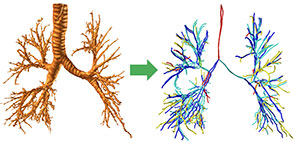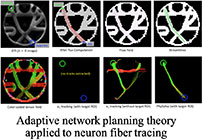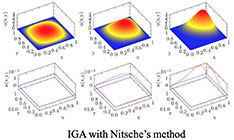Outline of our studies in 2019
For this CREST project, we set four main topics and promote collaboration among mathematical sciences and clinical medicine. Main outcomes during April 2019 – March 2020 are summarized below.
[A] Mathematical modeling of disease mechanisms and geometries of organs related to diagnosis and treatment

In 2019, for the diagnosis of interstitial pneumonia, we constructed an algorithm for automatic extraction and evaluation of geometrical characteristics of bronchi. This graph theoretical approach played an important role in mapping between different disease stages. In this topic, we have been elucidating blood flows in large vessels [1]. In 2019, we also started blood flow analysis of arteriovenous fistulae for use with hemodialysis, which have diverse morphologies at anastomosis sites (Suito G). For fluid–structure interaction analysis between blood flow and blood vessel motion, we extensively examined how left ventricle of the heart and aortic valve motions affect aortic blood flows [2] (Takizawa G).
- "Geometrical characteristics of human anatomical structure in thoracic diseases", H. Suito, Invited lecture at the 9th international congress on industrial and applied mathematics (ICIAM 2019) , University of Valencia, Valencia, Spain, 2019.7.
- "Heart valve isogeometric sequentially-coupled FSI analysis with the space–time topology change method”, Computational Mechanics", T. Terahara, K. Takizawa, T.E. Tezduyar, Y. Bazilevs, and M.-C. Hsu, Computational Mechanics, Vol. 65, pp. 1167-1187, 2020.
[B] Mathematical modeling for extraction of information by imaging and analytical techniques for medical images

In 2019, we made progresses in diffusion MRI research, which resolves micro-structures in living bodies by generative Q-space learning [1]. As an output, we produced and distributed our diffusion MRI analysis software as a freeware named "diMaRIA" [2]. In addition, for an additional feature of our software developed in 2018, we conducted several experiments for tracking the neural fiber tracts by a new technique by Physarum solver based on the adaptive network planning theory (Masutani G).
- "Diffusion MRI fiber tractography by flow field formation with extended physarum solver: A pilot study with 2D phantoms", Y. Masutani, MICCAI 2019 Workshop on computational diffusion MRI (CDMRI), Intercontinental Shenzhen, Shenzhen, China, 2019.10.
- Diffusion Magnetic Resonance Image Analyzer (diMaRIA) page http://www.medimg.info.hiroshima-cu.ac.jp/diMaRIA/diMaRIA.htm.
[C] Construction of diagnostic algorithms from medical data
For this effort, we are trying to construct deep learning systems for time series data accumulated from medical practice. Although electronic health record (EHR) data are used widely in hospitals, making good use those data entails many difficulties. With special additional funding from JST in 2019, a new software system with sufficient security measures, including personal information protections, was produced to extract such data without disturbing daily medical activities at hospitals. This system will be used to extend our research through wider utilization of actual medical data for mathematical modeling (Ueda G).
[D] Theoretical infrastructure for mathematical modeling applied to clinical medicine

Through this research, we are consolidating a mathematical basis for modeling of medical problems as mathematical infrastructure. In 2019, one of our efforts explored elliptic projection operators, which play an important role in guaranteeing the mathematical rationality of iso-geometric analysis (IGA) [1]. We also devoted attention to one-dimensional modeling of blood flows in human cardiovascular networks. In 2019, we constructed a discrete version of T. Kato’s theory for application to our problem, where various equalities and inequalities are used as defined in discrete partial difference methods. This work can be regarded as a new application of discrete partial difference methods (Saito G).
- "Stability and error estimates for the successive-projection technique with B-splines in time", Y. Ueda, N, Saito, Journal of Computational and Applied Mathematics,, Vol. 358, No. 1, pp. 266-278, 2019.